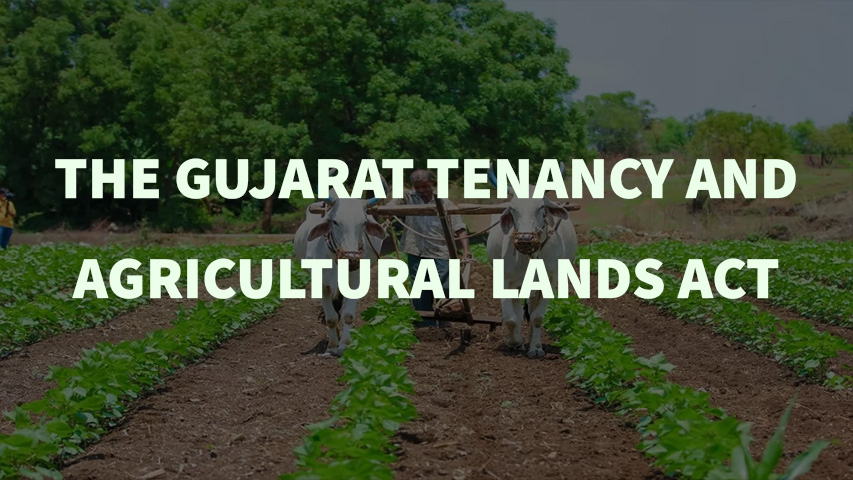
The Gujarat Tenancy and Agricultural Lands Act: Balancing the Interests of Landlords and Tenants
India's agricultural sector is providing employment and sustenance to millions in India. The state of Gujarat, with its rich agricultural landscapes, recognizes the importance of maintaining a good relationship between landlords and tenants for the sustainable growth of the sector. To maintain this balance, the Gujarat government implemented the Gujarat Tenancy and Agricultural Lands Act, 1948. This article aims to explore the various aspects of this act and analyze its effectiveness in ensuring equitable treatment for both landlords and tenants.
Contents
India's agricultural sector is providing employment and sustenance to millions in India. The state of Gujarat, with its rich agricultural landscapes, recognizes the importance of maintaining a good relationship between landlords and tenants for the sustainable growth of the sector. To maintain this balance, the Gujarat government implemented the Gujarat Tenancy and Agricultural Lands Act, 1948. This article aims to explore the various aspects of this act and analyze its effectiveness in ensuring equitable treatment for both landlords and tenants.
Contents
1. Historical Background
2. Key Provisions
3. Impact on Landlords
4. Challenges and Criticisms
2. Key Provisions
3. Impact on Landlords
4. Challenges and Criticisms
5. Closing Remarks
Historical Background
Prior to the enactment of The Gujarat Tenancy and Agricultural Lands Act, the state faced numerous agrarian crises, including unequal land distribution, exploitative tenancy agreements, and disputes arising from inadequate legal protections for both landlords and tenants. The act was enacted in 1948, and its subsequent amendments aimed to address these challenges while maintaining social justice and agricultural productivity.
Key Provisions
Fixation of Maximum Rent
The act provides for fixing the maximum rent payable by tenants, ensuring fairness and preventing excessive exploitation. The maximum rent is determined based on factors such as location, quality, and productivity of the land.
Prohibition of Subletting
The act prohibits the subletting of agricultural land to prevent exploitation and ensure that tenants directly cultivate the land they lease.
Security of Tenure
The act safeguards tenants' rights by providing them with security of tenure, preventing arbitrary eviction, and ensuring the continuity of their agricultural activities.
Right to Purchase
The act grants tenants the right to purchase the leased land from the landlord, ensuring a long-term stake in agricultural operations.
Dispute Resolution Mechanisms
The act establishes competent authorities to settle disputes between landlords and tenants promptly. These authorities act as mediators, offering a fair and effective process to resolve conflicts.
The act provides for fixing the maximum rent payable by tenants, ensuring fairness and preventing excessive exploitation. The maximum rent is determined based on factors such as location, quality, and productivity of the land.
Prohibition of Subletting
The act prohibits the subletting of agricultural land to prevent exploitation and ensure that tenants directly cultivate the land they lease.
Security of Tenure
The act safeguards tenants' rights by providing them with security of tenure, preventing arbitrary eviction, and ensuring the continuity of their agricultural activities.
Right to Purchase
The act grants tenants the right to purchase the leased land from the landlord, ensuring a long-term stake in agricultural operations.
Dispute Resolution Mechanisms
The act establishes competent authorities to settle disputes between landlords and tenants promptly. These authorities act as mediators, offering a fair and effective process to resolve conflicts.
Impact on Landlords
Fair Compensation
The act ensures that landlords receive fair compensation, reflecting the market value of their land. This prevents disputes and encourages smooth transitions in land ownership.
Encouragement of Mutual Cooperation
Through provisions such as the right to purchase, the act encourages landlords and tenants to work together harmoniously, fostering mutual cooperation and long-term stability on the land.
Simplified Dispute Resolution
The establishment of competent authorities provides a structured platform for resolving disputes, saving landlords' time and resources and reducing the burden on the judicial system.
The act ensures that landlords receive fair compensation, reflecting the market value of their land. This prevents disputes and encourages smooth transitions in land ownership.
Encouragement of Mutual Cooperation
Through provisions such as the right to purchase, the act encourages landlords and tenants to work together harmoniously, fostering mutual cooperation and long-term stability on the land.
Simplified Dispute Resolution
The establishment of competent authorities provides a structured platform for resolving disputes, saving landlords' time and resources and reducing the burden on the judicial system.
Impact on Tenants
Security of Tenure
The Act grants tenant security of tenure, protecting them from arbitrary evictions and allowing for long-term planning and investment in agricultural activities.
Fair Rent
By fixing maximum rents, the act safeguards tenants from exorbitant rent increases, ensuring that the benefits of agricultural productivity are shared equitably.
Enhanced Economic Opportunities
The provision allowing tenants the right to purchase land offers empowerment and enhanced economic opportunities, enabling tenants to become landowners and invest in their agricultural ventures.
Dispute Resolution Mechanism
The structured dispute resolution mechanism offers tenants a swift and impartial process for settling conflicts, ensuring their rights are protected.
Challenges and Criticisms
Lack of Awareness
A significant challenge is the lack of awareness among landlords and tenants about the provisions of the act, resulting in disputes and exploitation.
Implementation Issues
Inadequate coordination and enforcement mechanisms have hindered the effective implementation of the act, delaying dispute resolutions and perpetuating inequalities.
Outdated Land Valuation
Some critics argue that the land valuation methods prescribed in the act fail to account for rapid changes in market dynamics, potentially leading to unfair compensation for landlords.
Closing Remarks
The Gujarat Tenancy and Agricultural Lands Act plays a crucial role in striking a balance between the interests of landlords and tenants. By ensuring fair rent, security of tenure, and dispute resolution mechanisms, the act promotes sustainable agricultural practices and social justice. However, challenges related to implementation and awareness must be addressed to fully unlock the act's potential. By doing so, Gujarat can continue its journey towards inclusive agricultural growth and economic development.
